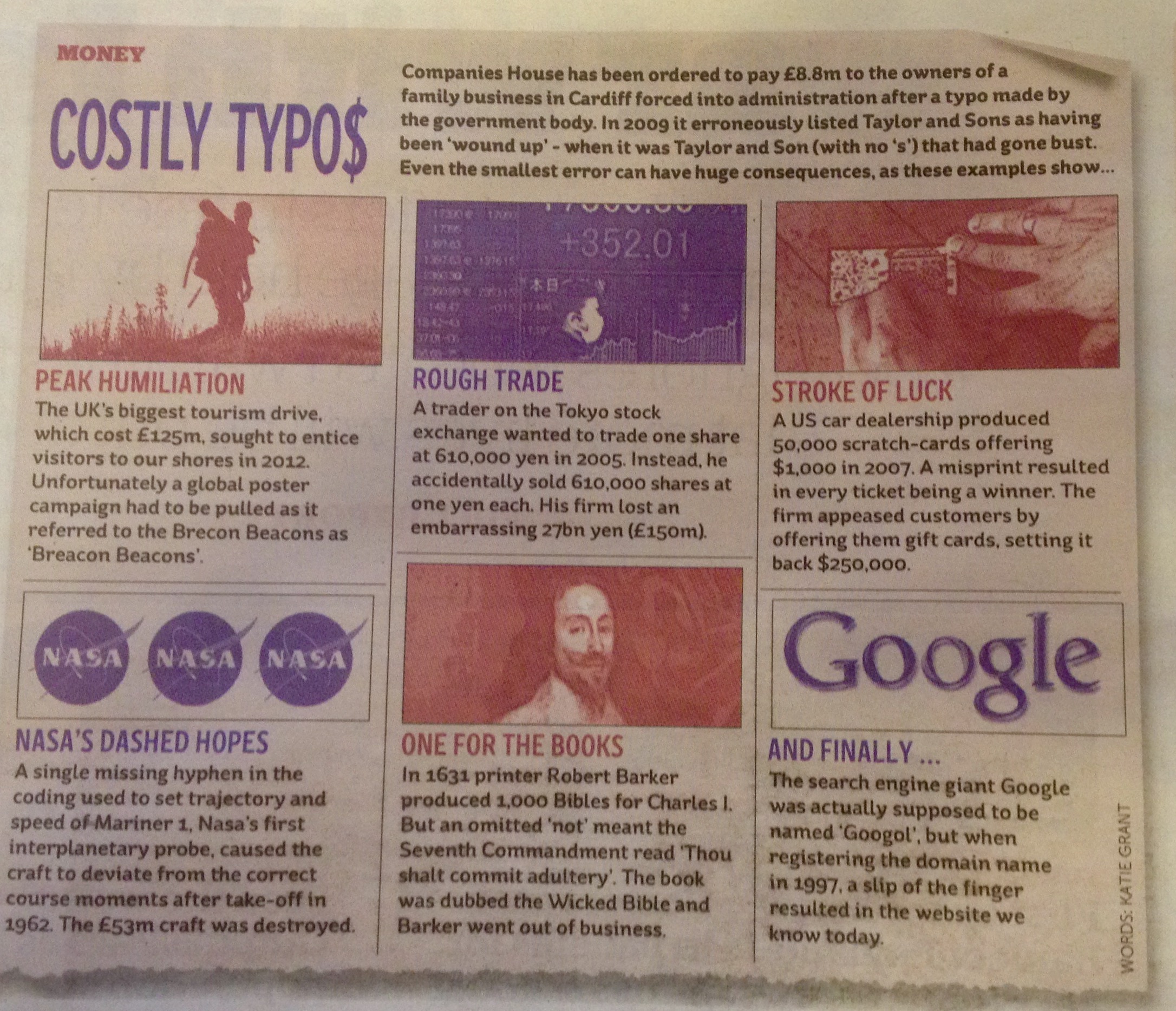Entries from February 2015 ↓
February 25th, 2015 — proofreading

I don’t know whether you saw it, but last week I posted on Briar Copywriting’s blog about the £8.8m proofreading blunder.
Well, according to a recent article in the i newspaper, it would appear that failing to proofread things isn’t modern day phenomena and it has led to some startling results.
Just in case the image above is hard to read, here are the 6 proofreading errors:
Peak Humiliation
The UK’s biggest tourism drive, which cost £125m, sought to entice visitors to our shores in 2012. Unfortunately, a global poster campaign had to be pulled as it referred to the Brecon Beacons as the ‘Breacon Beacons’.
Rough Trade
A trader on the Tokyo stick exchange wanted to trade one share at 610,000 yen in 2005. Instead, he accidentally sold 610,000 shares at one yen each. His firmlost an embarrassing 27bn yen (£150m).
Stroke of Luck
A US car dealership produced 50,000 scratch-cards offering $1,000 in 2007. A misprint resulted in every ticket being a winner. The firm appeased customers by offering them gift cards, setting it back $250,000.
NASA’s Dashed Hopes
A single missing hyphen in the coding used to set trajectory and speed of Mariner 1, NASA’s first interplanetary probe, caused the craft to deviate from the correct course moments after take-off in 1962. The £53m craft was destroyed.
One For The Books
In 1631 printer Robert Barker produced 1,000 Bibles for Charles I, but an omitted ‘not’ meant the Seventh Commandment read “Thou shalt commit adultery”. The book was dubbed the Wicked Bible and Barker went out of business.
And Finally…
The search engine giant Google was actually supposed to be named ‘Googol’, but when registering the domain name in 1997, a slip of the finger resulted in the website we know today.
Thanks i!
February 18th, 2015 — blog, blogging, blogging for business

As a blogger, it’s always nice to hear from people that read my stuff.
Recently, I received an email from a reader of my other blog, which is part of my business site, Briar Copywriting.
Basically, the guy thanked me for my advice, which he’d used to get him started as a blogger, but being new to the whole game wanted to know how he could write for an audience that didn’t yet exist.
The answer to that is simple.
Why are you blogging?
In this case the answer to that question is to promote a business.
You are the expert in your field and therefore should have lots to blog about.
For argument’s sake, let’s say you are a personal trainer and have started a blog to tempt people to your website.
Now think about your ideal customers – why would they come to you?
- Advice on fitness
- To loose weight
- To gain flexibility
- To improve their lifestyle…
Now all you have to do is write articles that encompass those things.
How do you know people will come?
You are offering the help and advice your potential clients are searching the internet for, therefore there’s a good chance your articles will come up in their search results. If you offer great information they’ll take a look at your website to learn more about what you can do for them.
See how it works?
Of course, you’ll also need to write with search engine optimisation in mind (using keywords), but remember to always write for your reader. By all means use keywords in your titles, sub headings and content, but your writing must be natural if you want Google to love it.
That’s about it.
If you’ve just started a blog to run along side your business, think about how you can add value to your readers and then create posts that solve the problems they are facing and will be searching Google for.
Just remember you’re not going to amass a huge following over night. Blogging takes time to gain momentum, but stick with it and you’ll never look back.
Author – Sally Ormond, Briar Copywriting Ltd.
February 11th, 2015 — blog, blogging, blogging for business

One of the toughest things you’ll be faced with as a blogger is the need for a constant stream of ideas for blog posts.
You audience are a demanding bunch and will want fresh, high quality information from you regularly.
So what happens, after a few weeks, when your ideas start to dry up?
That’s where this post will come in handy.
What follows are 8 sources of inspiration that will make sure you never run out of ideas.
1. Check out your FAQs
The chances are you’re faced with a lot of questions from your customers and I bet you get asked the same thing over and over.
Those questions will provide you with a list of potential blog topics. After all, if several customers have asked the question you can bet there are loads more out there thinking the same thing.
Not only will you have an endless list of ideas, you’ll also be improving your customer service by providing advice on the things that concern your customers the most.
2. “How to”
The humble “how to” post is a great way to cement your expert status.
Whether it’s the best way to train a dog, how to wear a tie, or how to get the most miles from a tank of fuel, your audience will love your advice and draw in a loyal readership.
3. Question and answer
Bringing in the point of view of others is a great way to add interest and depth to your blog.
Interviewing an industry expert, employee or even a customers will give a new dimension to your posts and could open up a whole raft of topic ideas for you.
Writing it in a Q&A format will also provide a change of pave to refresh your normal content.
4. Company news
Although your blog is not there for overly promotional posts, if you have an employee who’s done something extraordinary, or whether your company is involved in a charity event, there’s no harm in writing about it.
The employee angle is especially relevant as it gives an insight into your company and the people who work for you.
5. Education
Your knowledge is valuable.
People are searching the internet every day for information about what you do, so make sure you’re the one writing about it.
It doesn’t have to be exciting, but it does have to be interesting and relevant.
6. Lists
One of the most popular types of blog post are the top lists.
A list means there’s a lot of information in one place. Whether it’s like this one, or a list of useful websites, or products, it will prove to be a valuable resource guide.
7. Product reviews
OK, I’m not suggesting you give your product a favourable review and trash the competition, but if you have just found a new product or service that’s useful to you, think about whether it would be useful to your customers too.
Perhaps you researched several options before buying. If you did, think how beneficial that advice would be to someone with the same needs.
When looking for products your customers want expert help and who better to give them that help than you?
8. Use your YouTube videos
Rather than letting your YouTube videos gather dust, create blog posts around them. Perhaps they can be used to illustrate a particular point? If so, top and tail them with great content and before you know it you’ll have an informative blog post ready to be published.
Hopefully, these suggestions will get your creative juices flowing.
Do you have any other ideas for blog posts? If so leave a comment below and share them with me, I’d love to hear what you come up with.
Author – Sally Ormond, Briar Copywriting Ltd
February 4th, 2015 — Branding, copywriter, copywriting tips, Copywriting tone

What is a brand voice?
Basically, it’s the way your brand sounds to your readers.
That’s as clear as mud.
OK, look at it this way. When it comes to branding, the look, feel and words that you use have to work together to create an overall impression.
You probably have a pretty good idea of how you want your audience to see you. It could be as a high end brand, one that is innovative (Apple springs to mind) etc.
So where do words come into it?
Well, they have to paint a picture that is in line with your imagery, but there is one very important thing to remember.
What is it?
Your customer.
Even though you know how you want to be perceived, it’s just as important to understand how you want your customer to feel.
You may have lofty ideas of the type of language you want to use, but is it going to be right for your audience?
Think about who they are, why they would be interested in what you’re offering and what’s important to them. When you know that, you can tailor your writing to show them how you’re going to help them live the life they want to live.
It’s also important, especially when branding for a high end product, to show them why it’s so good. That doesn’t mean justifying the price tag, but rather highlighting the benefits it will bring:
- A sign of discernment
- Professional image
- Improve performance
It is the words that you use that will evoke an emotional connection to your brand. They will show your audience that your values are the same as their values and that by supporting your brand they are showing the world they are aligned with what you stand for.
Author – Sally Ormond, Briar Copywriting Ltd









